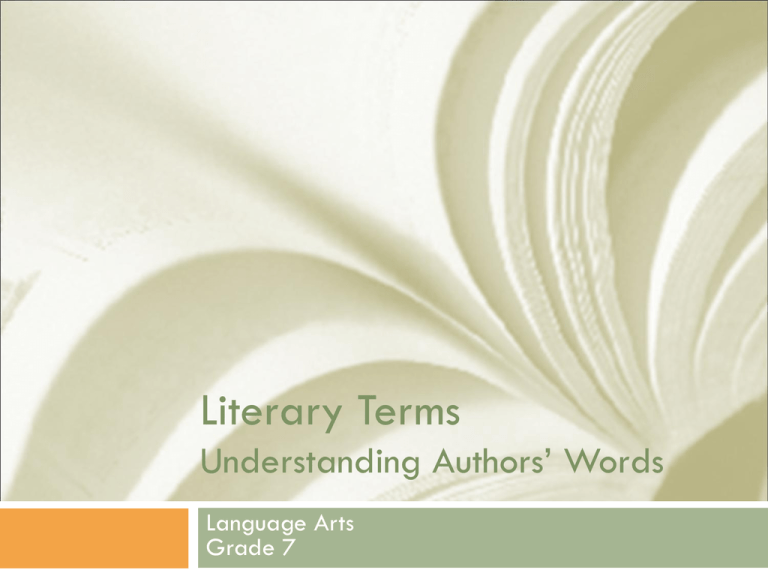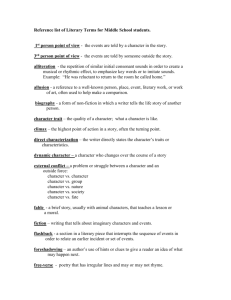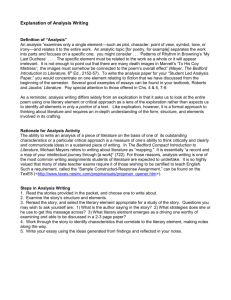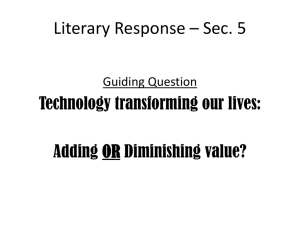Literary Terms Understanding Authors' Words
advertisement

Literary Terms Understanding Authors’ Words Language Arts Grade 7 Literary Terms Literary Terms are devices the author uses to make his or her writing more interesting. The devices contribute to the mood, meaning, or effect of the poem. Most literary terms can be found in prose (“regular text”) as well as poetry. Literary Terms Some of the definitions found in this presentation are not literary devices but are definitions of new literature-related words. The terms that follow this slide should be copied into your Reader’s Notebook under the “Literary Vocabulary” tab Paraphrase Definition: When you paraphrase something, you are putting it into your own words: Actual Text: Paraphrased Text: “I was a child and she was a child, In this kingdom by the sea; But we loved with a love that was more than loveI and my Annabel Lee; With a love that the winged seraphs of heaven Coveted her and me.” (Poe) The two of us were kids, In this seaside town; We loved each other a lot. Annabel Lee and I; The angels in heaven Wanted us to be with them. Connotation Definition: Refers to how you define a word based on its emotional meaning. For instance: I love pizza! Love in this case refers to enjoying something a great deal, but no harm will come if you don’t get pizza for dinner tonight. I love you! Love in this case refers to the emotional feelings one person has for another. If something happens in the relationship which causes it to fail, someone will be emotionally hurt. Theme Definition: The important message about life that the author is trying to convey in the literary piece. Often the theme is not stated directly. You must analyze the whole story to understand the message the author is conveying. There may be multiple themes in a poem or story. Imagery Definition: Words or phrases that appeal to one of the five senses. Look Sound Feel Taste Smell Imagery helps you to more fully understand the poem or story It makes you feel like part of the poem or story Simile Definition: Comparing two unlike things using like or as. I was as hungry as a bear. I am comparing myself to a bear The water sparkled like diamonds. The water is being compared to diamonds. Metaphor Definition: Comparing two unlike things without using like or as. John is a bull in a china shop. John is being compared to a bull; the metaphor helps the reader to understand that John is clumsy and probably will break things unintentionally. Life is a box of chocolates. (Forrest Gump) Life is being compared to a candy box. You never know what kind of chocolate you are going to get until you bite into it. Similarly, you never know what’s going to happen in life until you live it! Alliteration Definition: The repetition of initial consonant sounds. Used to draw a reader’s attention to certain words or ideas. For example: The sneaky snake slithered down the slimy path. Personification Definition: A non-human subject is given human characteristics. The bright sunlight winked at me from the sky. The tree waved its huge branches over the house. Repetition Definition: Two or more uses of the same sound, word, phrase, clause or sentence. “One step too far One day too long One trip to a star One lonely, sad song.” (“One” Kendjel) Rhyme Definition: The repetition of sounds at the end of words. “One step too far One day too long One trip to a star One lonely, sad song.” (“One” Kendjel) Onomatopoeia Definition: Words that imitate sounds For example: crash, buzz, jingle, hiss Hyperbole Definition: An exaggeration For example: I’m so hungry I could eat a horse! After we returned from our vacation, the mail was piled up to the sky. Diction Definition: A writer’s word choice and the way he puts words together. For example: I have a bad headache. I have an excruciating headache. Excruciating is a much stronger word than bad. The reader can sense the headache is very painful. Mood Definition: The feeling that is created in the reader by a literary work or passage. This is influenced by the author’s choice of words (diction), as well as his use of other literary devices. “The wind moaned outside the dirty window and I could see nothing except dark, mysterious shapes moving maddeningly in the distance. (Brown)” Forms of Poetry Each form of poetry has rules that guide its structure. Lyric poem: expresses the poet’s thoughts and feelings about a single image or idea in vivid , musical language. (“There Will Come Soft Rains”) Concrete poem: the poet uses graphical elements by arranging letters and lines. It creates a visual image that suggests the poem’s subject. (“Forsythia”) Haiku: traditional form of Japanese poetry that is often about nature. Graphic Elements Definition: Visual features that can influence a poem’s meaning. Capital letters Line length Word position



